Doors and doorways
Doorways can be one of the most difficult items to deal with. Most internal doors in our homes are 30 inches and if one measures from the inside of the door stops, the actual doorway clearance Door openings should have a minimum clearance of 32 inches measured from the outside of the door stops, providing the door can open 180 degrees. A door that opens less than 180 degrees will have the hinge side of the door reducing the doorway clearance, unless expandable door hinges are used, Figure 19.
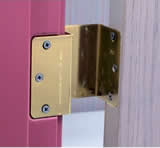
Figure 19 - Expandable door hinges
With the use of door stops, in order to obtain a minimum clearance of 32 inches you will most likely have to install a 34 inch door.
Lever style door handles, as shown in Figure 20 should be considered for all interior and exterior doors as these are easier to grip than round or tulip shaped door knobs.
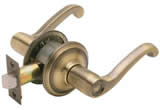
Figure 20 - Lever style passage set
Remember that an individual who is using a wheelchair or walker needs to be able to move out of the way of the swing of the door as it is opened.
Automatic door openers are now available that will open with the touch of a button, as shown in Figure 21
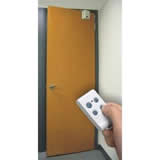
Figure 21 - Automatic door opener
Consideration can be given to pocket doors, as a pocket door does not require swinging space nor does it require door stop trim. There are however, a couple of negatives with respect to the installation of pocket doors.
Additional information on pocket doors
Pocket doors generally do not provide the noise attenuation that is obtained from a regular hinged door.
The hardware available to open and close a pocket door can be difficult for anyone with dexterity problems to operate.
Vanities and basins
Vanities range in height from 30 inches to 36 inches with the most common being at 34 inches. Providing a height that is perfect for all members of a family and their guests is almost impossible. Children would benefit from a lower vanity, as would shorter individuals and those using wheelchairs, while tall people would find a 36 inch vanity more comfortable.
Although there are adjustable height vanities, they are very expensive and out of reach of most homeowners and in many cases not worth the price for a modicum of comfort.
One of the most important features for the vanity is that it provides knee space, as shown in Figure 22. The knee space provides wheelchair access to the vanity basin.
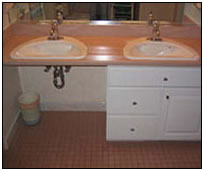
Figure 22 - Vanity with knee space under sink area
The knee space, under the vanity should be at least 32 inches wide, with a clear depth of 24 inches. However, the clear depth of 24 inches is not usually possible considering the basin drain, cold and hot water pipes.
A second consideration should be in the basin design. A basin that has a drain towards the back of the fixture as shown in Figure 23, rather than in the center, as shown in Figure 24 provides substantially more knee space. As well, with the drainage and hot water lines against the wall, it is less likely that someone seated at the sink will burn themselves by accidentally touching hot pipes.
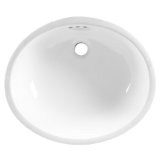
Figure 23 - Basin with drain in towards back of bowl
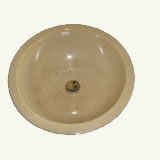
Figure 24 - Basin with drain in center of bowl
Selection of vanity basins.
Always mount the plumbing as far back as possible.

